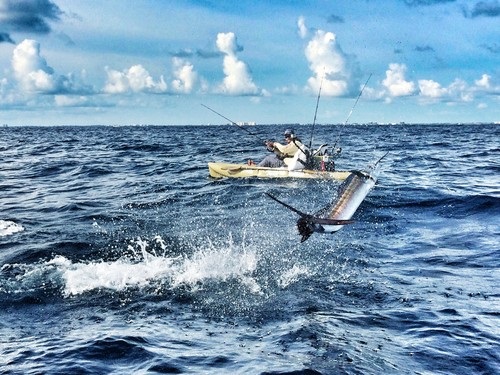 Sailfish can reach speeds up to 65mph, weigh 100lbs and are very acrobatic when hooked. They are frequently targeted and caught by anglers year round off the South Florida coast. Most people think that landing one of these majestic creatures
Sailfish can reach speeds up to 65mph, weigh 100lbs and are very acrobatic when hooked. They are frequently targeted and caught by anglers year round off the South Florida coast. Most people think that landing one of these majestic creatures
can only be done in a center console or sport fishing boat, but I’m about to blow some minds. Not only can these fish be caught and released from a kayak, they can be landed fairly easily with the right equipment and technique.

The Set Up
The most widely used technique is slow trolling or drifting. Tackle for targeting sailfish is very specific; a 6’6” to 7” 30-50lb rod, with a reel that will hold at least 300 yards is the ideal setup. I use spinning reels because that’s what I am accustomed too, but a conventional reel works just as well. I prefer braided line for my flat lines; some anglers insist on using mono for the stretch it provides. I have never had issues with braid and it gives you more line capacity without having to use a big heavy reel. Braid in the 30-40lb class combined with 15 feet of 40-60lb fluorocarbon leader has proven to be an effective combination. If you are using mono 25-30lb main line tie-on the same 15 feet of 40-60lb leader. The size of the hook will depend on the size of your bait; smaller bait means a smaller hook. I use a 5/0-7/0 inline circle hook exclusively. If you are specifically targeting sails a circle hook should always be used to ensure a healthy release, not to mention it is the law.

Properly Rigging Live Bait
There are many types of bait to use for sailfish from live goggle eye to dead squid. The top two baits are live goggle eye or small blue runners which are small fin bait species. You can rig these baits through the nostrils or for a better hook up ratio, bridle the bait. To properly bridle a bait take a rubber band and lay it across the curve of the hook, put one loop through the other and tighten the band onto the hook. I recommend to do this to a few hooks before getting on the water as it can be a pain with wet hands. Now using a bridling needle thread the rubber band through the bait just above the eyes. Once the needle is all the way through the bait, the hook should be on one side and a loop of the band on the other. Take the hook point and put it through the loop sticking out the other side of the bait. Spin the hook tightening the band until it is snug on top of the baits head, then put the hook point underneath the twist and it should sit tight against the bait with the hook point facing the rear of the bait. This technique will expose the entire hook for a better shot at hooking the fish. When slow trolling you want to go just fast enough to keep the bait away from your kayak. If you think you are going slow, go slower. I like to be moving at about one to one and a half miles per hour. A slow drift can be used when there is enough current or wind to keep the bait out away from the kayak. The obvious disadvantage of drifting: you can’t cover as much water.
Sailfish are attracted to structure, drop offs, current and temperature changes in depths from 40’-300’. When you begin slow trolling for sailfish, start shallow and work your way to deeper water in a zigzag pattern. Moving shallow to deep and deep to shallow repeatedly will help you find fish quicker. Once a fish is hooked mark that area and continue fishing in the area because sailfish often travel in packs.
Keep your drag loose
A lot of times sailfish hit the bait with its bill or hold it in its mouth then drops the bait immediately when they feel the tension of your line. If and when that happens, free spool your bait. Most of the time sailfish will turn right around and pick it back up. When the fish finally commits and takes off with the bait engage your reel keeping constant tension. When that sail feels that hook in its mouth it will go nuts dancing across the surface in all directions.
Keep in mind that a sailfish bill is a weapon. Be aware of where the fish is at all times. You can imagine what can happen it that bill hits you or the fish lands on your kayak after a jump. Stay focused and keep the line tight with the fish, this will also prevent the hook being thrown. Usually after 5-10 jumps sailfish go into “drag mode” and tow you around with little jumps. Put some heat on the fish and pull hard to tire it out or you could be pulled around for a while. It’s important to land them as fast as possible to ensure a good release.
When landing a sailfish use a pair of gloves to handle the bill of the fish, as it will destroy your hand if you have nothing to cover it. Snap a quick photo and take the time to revive it. They are an amazing fish and a lot of fun to catch. Remember the right place, the right time, the right bait and proper presentation is all it takes to land your first sailfish. See you on the water. by
